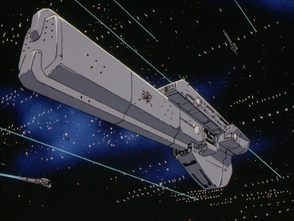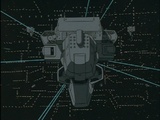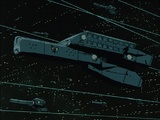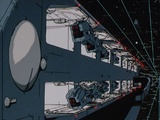Imperial carrier (788 UC era)
From Gineipaedia, the Legend of Galactic Heroes wiki
 Imperial carrier (794 UC (485 IC / 3594 CE)) | |
| Affiliation: | Galactic Empire |
| Type: | Carrier |
| Length: | 1110 metres (FFC12) |
| Width: | 230 metres (FFC12) |
| Height: | 320 metres (FFC12) |
| Armament: | 16 forward beam cannons 120 Walküre fighters or 32 gunships |
| Crew: | 1879 |
This Imperial carrier (Japanese: 空母) design served as the standard carrier design of Imperial fleets from the late stages of the Alliance–Imperial War to at least 801 UC (3 NIC / 492 IC / 3601 CE).
Contents |
Design
The standard Imperial carrier design had a hull that shared common features with large Imperial battleships like the Wilhelmina. It could be distinguished from the latter, by the large box-like hangar module on top, slightly different engine nacelle arrangement, an area of exposed machinery on each side underneath the hangar module, and also by the different side gun arrangement on the hull.
Fighter recovery was accomplished through ports in the sides of the hangar.
A second variant carried Imperial gunships. The only visual difference was a different hangar module, with 16 doors on each side. The gunships were launched by first being lifted out of the ship by cranes. During this time, the gunships and the carrier itself were vulnerable and there was at least one recorded instance of a carrier and its gunships being hit during the launch process, resulting in the destruction of all through secondary explosions. (LOGH: 'The Battle of Vermilion (Part One)')
Gallery
Frontal view (800 UC (2 NIC / 491 IC / 3600 CE)) |
Gunship carrier (799 UC (1 NIC / 490 IC / 3599 CE)) |
Gunship carrier launching (799 UC (1 NIC / 490 IC / 3599 CE)) |
Appendices
Licensed sources
The miniaturization of laser fusion missiles, using inertial confinement fusion, to the point where a ship-killing missile could be carried on a small craft was a key factor in the rise of the importance of small craft. Space combat had previously involved large ships with large reactors to power their cannons, and the resulting size of ships resulted in lower maneuverability. This rendered them vulnerable to the close ranged attacks of small craft, though in turn these smaller craft were limited by their hull size and so had more limited sensors and lacked warp engines.
The Free Planets Alliance first fielded carriers in 750 UC (441 IC / 3550 CE) but the Galactic Empire continued to prioritize construction of battleships and cruisers. It was not until 780 UC (471 IC / 3580 CE), after the design of the Alliance Lazarus class carrier, that the Empire belatedly acknowledged the usefulness of carriers and resolved to build its own.
The Empire decided to adapt an existing design to reduce development time and chose the Wilhelmina class battleship design. Though the outward appearance was similar, the weapon systems and engines were downgraded. The cannons were short range and only half the calibre of the original versions and the engines were more like those on transport ships. Extensive data processing and communication equipment was added to coordinate the carried small craft.
A large hangar module was added on top of the hull to carry a large complement of fighters. This module housed the pilot quarters, fuel, and munitions for the fighters. Each fighter was launched and recovered using navigational laser guidance from its own individual launch port or cell, which had no atmosphere. The lack of atmosphere meant any crew or maintenance personnel would have needed to wear airtight clothing before entering the cell. Each cell opened up directly to space so an explosion in one cell would not cause damage in adjacent cells. However it was not uncommon for large calibre beam cannon hits to the hangar module to cause the entire hangar to explode.
The gunship carrier variant differed only in the hangar module and was otherwise identical to the fighter carrier. (Fleet File Collection Vol.12, Data Book: Mechanic & Seiyū Encyclopaedia, p. 141, 172)
Apocrypha
DVD features
A production sketch of the Imperial carrier appears in the DVD features.



